technical specifications FIAT DUCATO BASE CAMPER 2017 Owner handbook (in English)
[x] Cancel search | Manufacturer: FIAT, Model Year: 2017, Model line: DUCATO BASE CAMPER, Model: FIAT DUCATO BASE CAMPER 2017Pages: 296, PDF Size: 14.44 MB
Page 3 of 296
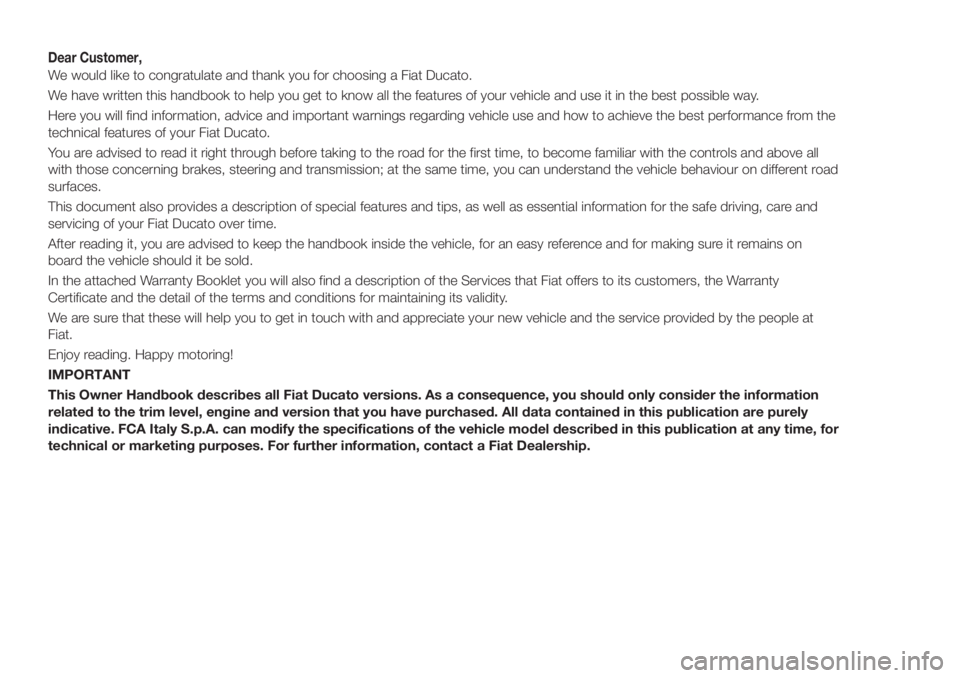
Dear Customer,
We would like to congratulate and thank you for choosing a Fiat Ducato.
We have written this handbook to help you get to know all the features of your vehicle and use it in the best possible way.
Here you will find information, advice and important warnings regarding vehicle use and how to achieve the best performance from the
technical features of your Fiat Ducato.
You are advised to read it right through before taking to the road for the first time, to become familiar with the controls and above all
with those concerning brakes, steering and transmission; at the same time, you can understand the vehicle behaviour on different road
surfaces.
This document also provides a description of special features and tips, as well as essential information for the safe driving, care and
servicing of your Fiat Ducato over time.
After reading it, you are advised to keep the handbook inside the vehicle, for an easy reference and for making sure it remains on
board the vehicle should it be sold.
In the attached Warranty Booklet you will also find a description of the Services that Fiat offers to its customers, the Warranty
Certificate and the detail of the terms and conditions for maintaining its validity.
We are sure that these will help you to get in touch with and appreciate your new vehicle and the service provided by the people at
Fiat.
Enjoy reading. Happy motoring!
IMPORTANT
This Owner Handbook describes all Fiat Ducato versions. As a consequence, you should only consider the information
related to the trim level, engine and version that you have purchased. All data contained in this publication are purely
indicative. FCA Italy S.p.A. can modify the specifications of the vehicle model described in this publication at any time, for
technical or marketing purposes. For further information, contact a Fiat Dealership.
Page 145 of 296
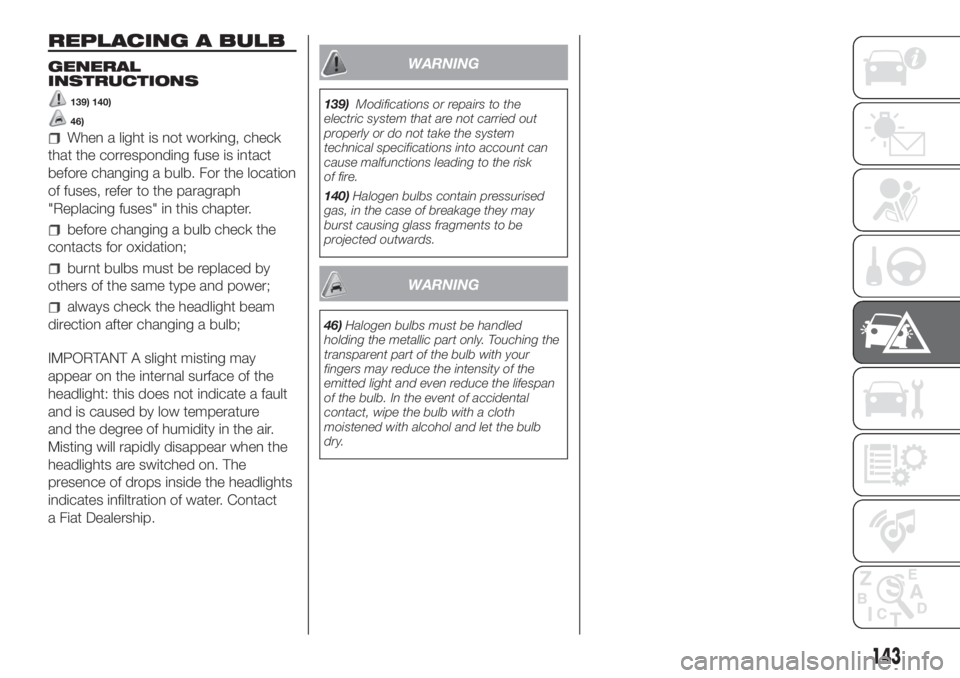
REPLACING A BULB
GENERAL
INSTRUCTIONS
139) 140)
46)
When a light is not working, check
that the corresponding fuse is intact
before changing a bulb. For the location
of fuses, refer to the paragraph
"Replacing fuses" in this chapter.
before changing a bulb check the
contacts for oxidation;
burnt bulbs must be replaced by
others of the same type and power;
always check the headlight beam
direction after changing a bulb;
IMPORTANT A slight misting may
appear on the internal surface of the
headlight: this does not indicate a fault
and is caused by low temperature
and the degree of humidity in the air.
Misting will rapidly disappear when the
headlights are switched on. The
presence of drops inside the headlights
indicates infiltration of water. Contact
a Fiat Dealership.
WARNING
139)Modifications or repairs to the
electric system that are not carried out
properly or do not take the system
technical specifications into account can
cause malfunctions leading to the risk
of fire.
140)Halogen bulbs contain pressurised
gas, in the case of breakage they may
burst causing glass fragments to be
projected outwards.
WARNING
46)Halogen bulbs must be handled
holding the metallic part only. Touching the
transparent part of the bulb with your
fingers may reduce the intensity of the
emitted light and even reduce the lifespan
of the bulb. In the event of accidental
contact, wipe the bulb with a cloth
moistened with alcohol and let the bulb
dry.
143
Page 176 of 296
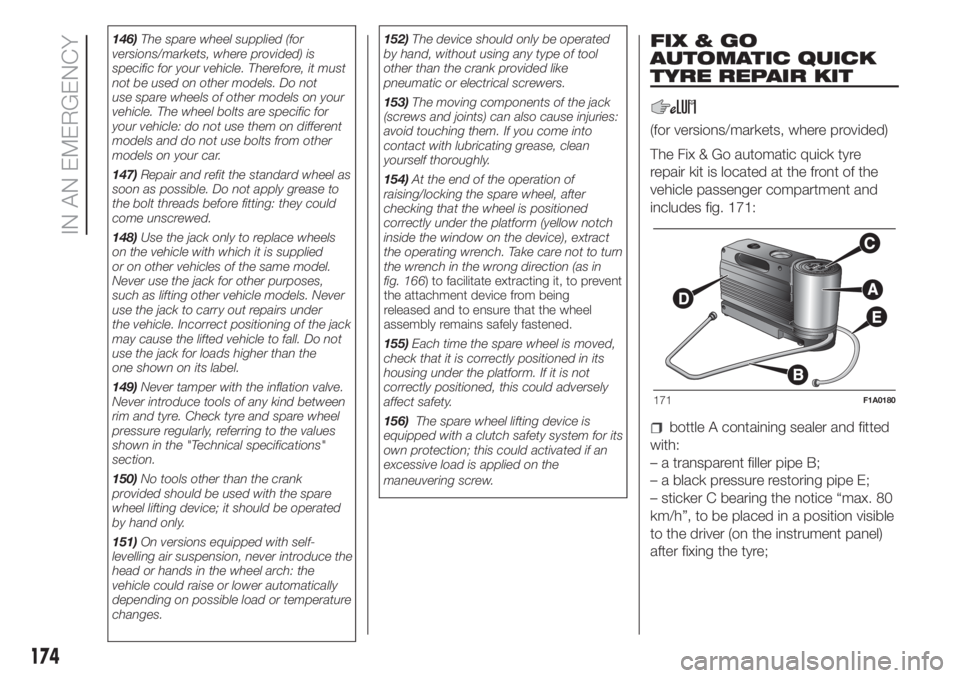
146)The spare wheel supplied (for
versions/markets, where provided) is
specific for your vehicle. Therefore, it must
not be used on other models. Do not
use spare wheels of other models on your
vehicle. The wheel bolts are specific for
your vehicle: do not use them on different
models and do not use bolts from other
models on your car.
147)Repair and refit the standard wheel as
soon as possible. Do not apply grease to
the bolt threads before fitting: they could
come unscrewed.
148)Use the jack only to replace wheels
on the vehicle with which it is supplied
or on other vehicles of the same model.
Never use the jack for other purposes,
such as lifting other vehicle models. Never
use the jack to carry out repairs under
the vehicle. Incorrect positioning of the jack
may cause the lifted vehicle to fall. Do not
use the jack for loads higher than the
one shown on its label.
149)Never tamper with the inflation valve.
Never introduce tools of any kind between
rim and tyre. Check tyre and spare wheel
pressure regularly, referring to the values
shown in the "Technical specifications"
section.
150)No tools other than the crank
provided should be used with the spare
wheel lifting device; it should be operated
by hand only.
151)On versions equipped with self-
levelling air suspension, never introduce the
head or hands in the wheel arch: the
vehicle could raise or lower automatically
depending on possible load or temperature
changes.152)The device should only be operated
by hand, without using any type of tool
other than the crank provided like
pneumatic or electrical screwers.
153)The moving components of the jack
(screws and joints) can also cause injuries:
avoid touching them. If you come into
contact with lubricating grease, clean
yourself thoroughly.
154)At the end of the operation of
raising/locking the spare wheel, after
checking that the wheel is positioned
correctly under the platform (yellow notch
inside the window on the device), extract
the operating wrench. Take care not to turn
the wrench in the wrong direction (as in
fig. 166) to facilitate extracting it, to prevent
the attachment device from being
released and to ensure that the wheel
assembly remains safely fastened.
155)Each time the spare wheel is moved,
check that it is correctly positioned in its
housing under the platform. If it is not
correctly positioned, this could adversely
affect safety.
156)The spare wheel lifting device is
equipped with a clutch safety system for its
own protection; this could activated if an
excessive load is applied on the
maneuvering screw.FIX & GO
AUTOMATIC QUICK
TYRE REPAIR KIT
(for versions/markets, where provided)
The Fix & Go automatic quick tyre
repair kit is located at the front of the
vehicle passenger compartment and
includes fig. 171:
bottle A containing sealer and fitted
with:
– a transparent filler pipe B;
– a black pressure restoring pipe E;
– sticker C bearing the notice “max. 80
km/h”, to be placed in a position visible
to the driver (on the instrument panel)
after fixing the tyre;
171F1A0180
174
IN AN EMERGENCY
Page 199 of 296
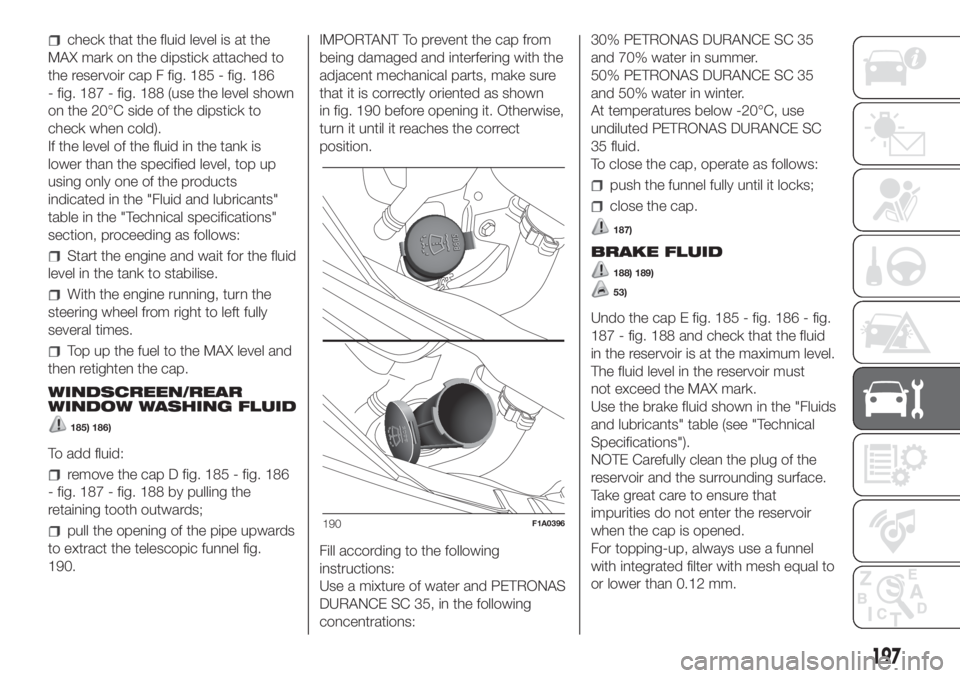
check that the fluid level is at the
MAX mark on the dipstick attached to
the reservoir cap F fig. 185 - fig. 186
- fig. 187 - fig. 188 (use the level shown
on the 20°C side of the dipstick to
check when cold).
If the level of the fluid in the tank is
lower than the specified level, top up
using only one of the products
indicated in the "Fluid and lubricants"
table in the "Technical specifications"
section, proceeding as follows:
Start the engine and wait for the fluid
level in the tank to stabilise.
With the engine running, turn the
steering wheel from right to left fully
several times.
Top up the fuel to the MAX level and
then retighten the cap.
WINDSCREEN/REAR
WINDOW WASHING FLUID
185) 186)
To add fluid:
remove the cap D fig. 185 - fig. 186
- fig. 187 - fig. 188 by pulling the
retaining tooth outwards;
pull the opening of the pipe upwards
to extract the telescopic funnel fig.
190.IMPORTANT To prevent the cap from
being damaged and interfering with the
adjacent mechanical parts, make sure
that it is correctly oriented as shown
in fig. 190 before opening it. Otherwise,
turn it until it reaches the correct
position.
Fill according to the following
instructions:
Use a mixture of water and PETRONAS
DURANCE SC 35, in the following
concentrations:30% PETRONAS DURANCE SC 35
and 70% water in summer.
50% PETRONAS DURANCE SC 35
and 50% water in winter.
At temperatures below -20°C, use
undiluted PETRONAS DURANCE SC
35 fluid.
To close the cap, operate as follows:
push the funnel fully until it locks;
close the cap.
187)
BRAKE FLUID
188) 189)
53)
Undo the cap E fig. 185 - fig. 186 - fig.
187 - fig. 188 and check that the fluid
in the reservoir is at the maximum level.
The fluid level in the reservoir must
not exceed the MAX mark.
Use the brake fluid shown in the "Fluids
and lubricants" table (see "Technical
Specifications").
NOTE Carefully clean the plug of the
reservoir and the surrounding surface.
Take great care to ensure that
impurities do not enter the reservoir
when the cap is opened.
For topping-up, always use a funnel
with integrated filter with mesh equal to
or lower than 0.12 mm.
190F1A0396
197
Page 205 of 296
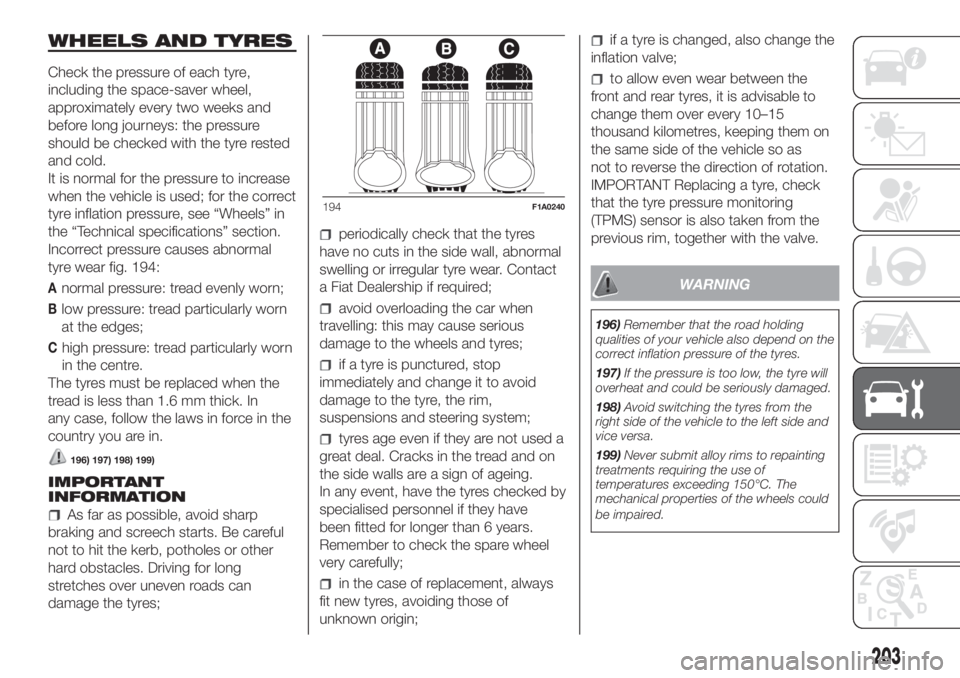
WHEELS AND TYRES
Check the pressure of each tyre,
including the space-saver wheel,
approximately every two weeks and
before long journeys: the pressure
should be checked with the tyre rested
and cold.
It is normal for the pressure to increase
when the vehicle is used; for the correct
tyre inflation pressure, see “Wheels” in
the “Technical specifications” section.
Incorrect pressure causes abnormal
tyre wear fig. 194:
Anormal pressure: tread evenly worn;
Blow pressure: tread particularly worn
at the edges;
Chigh pressure: tread particularly worn
in the centre.
The tyres must be replaced when the
tread is less than 1.6 mm thick. In
any case, follow the laws in force in the
country you are in.
196) 197) 198) 199)
IMPORTANT
INFORMATION
As far as possible, avoid sharp
braking and screech starts. Be careful
not to hit the kerb, potholes or other
hard obstacles. Driving for long
stretches over uneven roads can
damage the tyres;
periodically check that the tyres
have no cuts in the side wall, abnormal
swelling or irregular tyre wear. Contact
a Fiat Dealership if required;
avoid overloading the car when
travelling: this may cause serious
damage to the wheels and tyres;
if a tyre is punctured, stop
immediately and change it to avoid
damage to the tyre, the rim,
suspensions and steering system;
tyres age even if they are not used a
great deal. Cracks in the tread and on
the side walls are a sign of ageing.
In any event, have the tyres checked by
specialised personnel if they have
been fitted for longer than 6 years.
Remember to check the spare wheel
very carefully;
in the case of replacement, always
fit new tyres, avoiding those of
unknown origin;
if a tyre is changed, also change the
inflation valve;
to allow even wear between the
front and rear tyres, it is advisable to
change them over every 10–15
thousand kilometres, keeping them on
the same side of the vehicle so as
not to reverse the direction of rotation.
IMPORTANT Replacing a tyre, check
that the tyre pressure monitoring
(TPMS) sensor is also taken from the
previous rim, together with the valve.
WARNING
196)Remember that the road holding
qualities of your vehicle also depend on the
correct inflation pressure of the tyres.
197)If the pressure is too low, the tyre will
overheat and could be seriously damaged.
198)Avoid switching the tyres from the
right side of the vehicle to the left side and
vice versa.
199)Never submit alloy rims to repainting
treatments requiring the use of
temperatures exceeding 150°C. The
mechanical properties of the wheels could
be impaired.
194F1A0240
203
Page 207 of 296
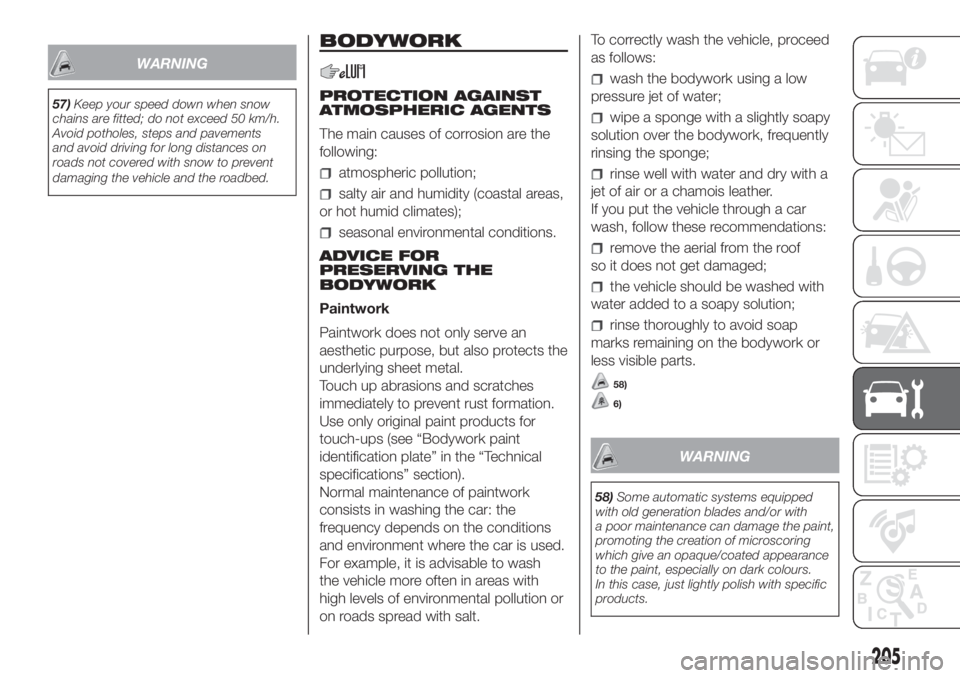
WARNING
57)Keep your speed down when snow
chains are fitted; do not exceed 50 km/h.
Avoid potholes, steps and pavements
and avoid driving for long distances on
roads not covered with snow to prevent
damaging the vehicle and the roadbed.
BODYWORK
PROTECTION AGAINST
ATMOSPHERIC AGENTS
The main causes of corrosion are the
following:
atmospheric pollution;
salty air and humidity (coastal areas,
or hot humid climates);
seasonal environmental conditions.
ADVICE FOR
PRESERVING THE
BODYWORK
Paintwork
Paintwork does not only serve an
aesthetic purpose, but also protects the
underlying sheet metal.
Touch up abrasions and scratches
immediately to prevent rust formation.
Use only original paint products for
touch-ups (see “Bodywork paint
identification plate” in the “Technical
specifications” section).
Normal maintenance of paintwork
consists in washing the car: the
frequency depends on the conditions
and environment where the car is used.
For example, it is advisable to wash
the vehicle more often in areas with
high levels of environmental pollution or
on roads spread with salt.To correctly wash the vehicle, proceed
as follows:
wash the bodywork using a low
pressure jet of water;
wipe a sponge with a slightly soapy
solution over the bodywork, frequently
rinsing the sponge;
rinse well with water and dry with a
jet of air or a chamois leather.
If you put the vehicle through a car
wash, follow these recommendations:
remove the aerial from the roof
so it does not get damaged;
the vehicle should be washed with
water added to a soapy solution;
rinse thoroughly to avoid soap
marks remaining on the bodywork or
less visible parts.
58)
6)
WARNING
58)Some automatic systems equipped
with old generation blades and/or with
a poor maintenance can damage the paint,
promoting the creation of microscoring
which give an opaque/coated appearance
to the paint, especially on dark colours.
In this case, just lightly polish with specific
products.
205
Page 244 of 296
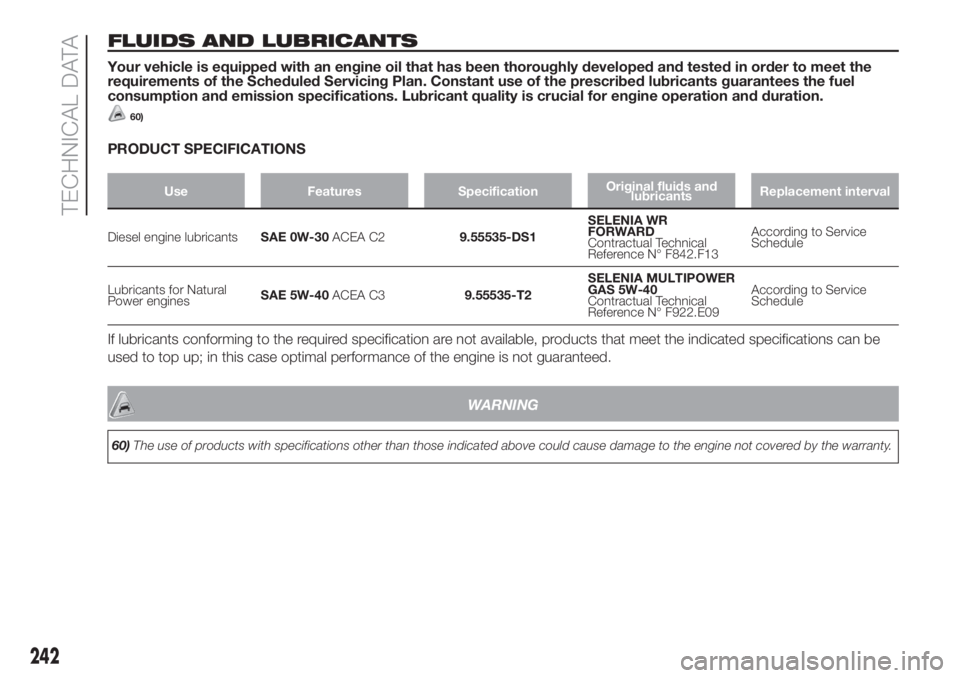
FLUIDS AND LUBRICANTS
Your vehicle is equipped with an engine oil that has been thoroughly developed and tested in order to meet the
requirements of the Scheduled Servicing Plan. Constant use of the prescribed lubricants guarantees the fuel
consumption and emission specifications. Lubricant quality is crucial for engine operation and duration.
60)
PRODUCT SPECIFICATIONS
Use Features SpecificationOriginal fluids and
lubricantsReplacement interval
Diesel engine lubricantsSAE 0W-30ACEA C29.55535-DS1SELENIA WR
FORWARD
Contractual Technical
Reference N° F842.F13According to Service
Schedule
Lubricants for Natural
Power enginesSAE 5W-40ACEA C39.55535-T2SELENIA MULTIPOWER
GAS 5W-40
Contractual Technical
Reference N° F922.E09According to Service
Schedule
If lubricants conforming to the required specification are not available, products that meet the indicated specifications can be
used to top up; in this case optimal performance of the engine is not guaranteed.
WARNING
60)The use of products with specifications other than those indicated above could cause damage to the engine not covered by the warranty.
242
TECHNICAL DATA
Page 245 of 296
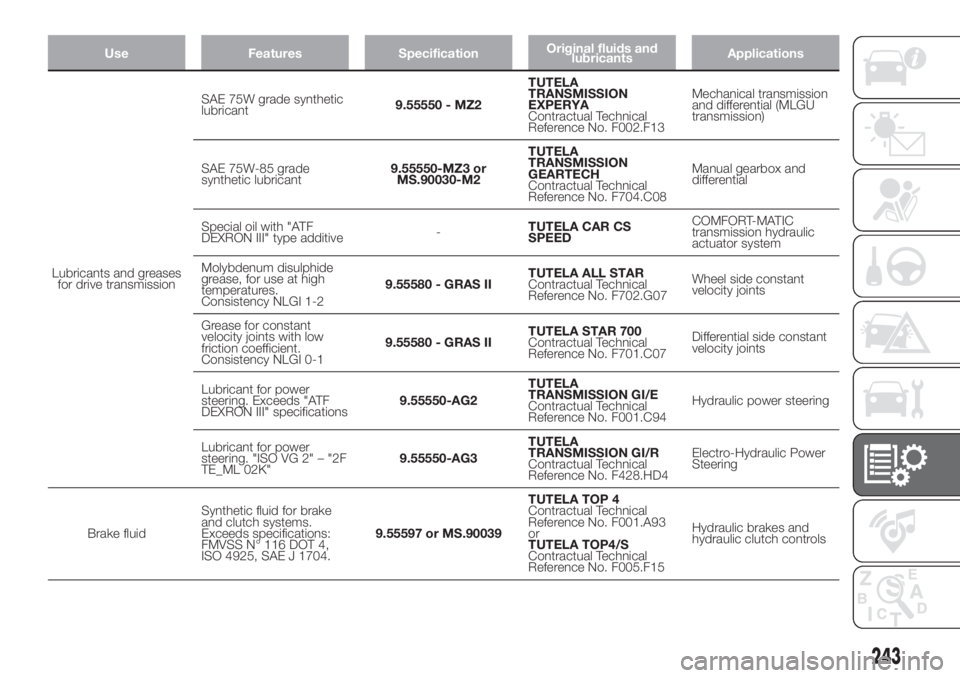
Use Features SpecificationOriginal fluids and
lubricantsApplications
Lubricants and greases
for drive transmissionSAE 75W grade synthetic
lubricant9.55550 - MZ2TUTELA
TRANSMISSION
EXPERYA
Contractual Technical
Reference No. F002.F13Mechanical transmission
and differential (MLGU
transmission)
SAE 75W-85 grade
synthetic lubricant9.55550-MZ3 or
MS.90030-M2TUTELA
TRANSMISSION
GEARTECH
Contractual Technical
Reference No. F704.C08Manual gearbox and
differential
Special oil with "ATF
DEXRON III" type additive-TUTELA CAR CS
SPEEDCOMFORT-MATIC
transmission hydraulic
actuator system
Molybdenum disulphide
grease, for use at high
temperatures.
Consistency NLGI 1-29.55580 - GRAS IITUTELA ALL STAR
Contractual Technical
Reference No. F702.G07Wheel side constant
velocity joints
Grease for constant
velocity joints with low
friction coefficient.
Consistency NLGI 0-19.55580 - GRAS IITUTELA STAR 700
Contractual Technical
Reference No. F701.C07Differential side constant
velocity joints
Lubricant for power
steering. Exceeds "ATF
DEXRON III" specifications9.55550-AG2TUTELA
TRANSMISSION GI/E
Contractual Technical
Reference No. F001.C94Hydraulic power steering
Lubricant for power
steering. "ISO VG 2" – "2F
TE_ML 02K"9.55550-AG3TUTELA
TRANSMISSION GI/R
Contractual Technical
Reference No. F428.HD4Electro-Hydraulic Power
Steering
Brake fluidSynthetic fluid for brake
and clutch systems.
Exceeds specifications:
FMVSS N° 116 DOT 4,
ISO 4925, SAE J 1704.9.55597 or MS.90039TUTELA TOP 4
Contractual Technical
Reference No. F001.A93
or
TUTELA TOP4/S
Contractual Technical
Reference No. F005.F15Hydraulic brakes and
hydraulic clutch controls
243
Page 246 of 296
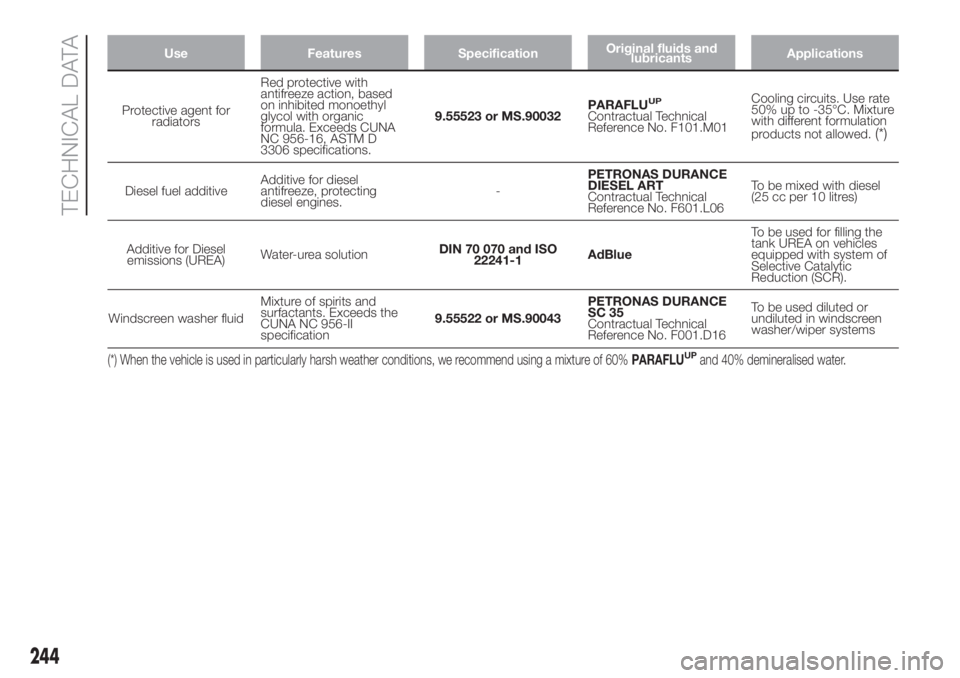
Use Features SpecificationOriginal fluids and
lubricantsApplications
Protective agent for
radiatorsRed protective with
antifreeze action, based
on inhibited monoethyl
glycol with organic
formula. Exceeds CUNA
NC 956-16, ASTM D
3306 specifications.9.55523 or MS.90032PARAFLUUP
Contractual Technical
Reference No. F101.M01Cooling circuits. Use rate
50% up to -35°C. Mixture
with different formulation
products not allowed.
(*)
Diesel fuel additiveAdditive for diesel
antifreeze, protecting
diesel engines.-PETRONAS DURANCE
DIESEL ART
Contractual Technical
Reference No. F601.L06To be mixed with diesel
(25 cc per 10 litres)
Additive for Diesel
emissions (UREA)Water-urea solutionDIN 70 070 and ISO
22241-1AdBlueTo be used for filling the
tank UREA on vehicles
equipped with system of
Selective Catalytic
Reduction (SCR).
Windscreen washer fluidMixture of spirits and
surfactants. Exceeds the
CUNA NC 956-II
specification9.55522 or MS.90043PETRONAS DURANCE
SC 35
Contractual Technical
Reference No. F001.D16To be used diluted or
undiluted in windscreen
washer/wiper systems
(*) When the vehicle is used in particularly harsh weather conditions, we recommend using a mixture of 60%PARAFLUUPand 40% demineralised water.
244
TECHNICAL DATA
Page 285 of 296
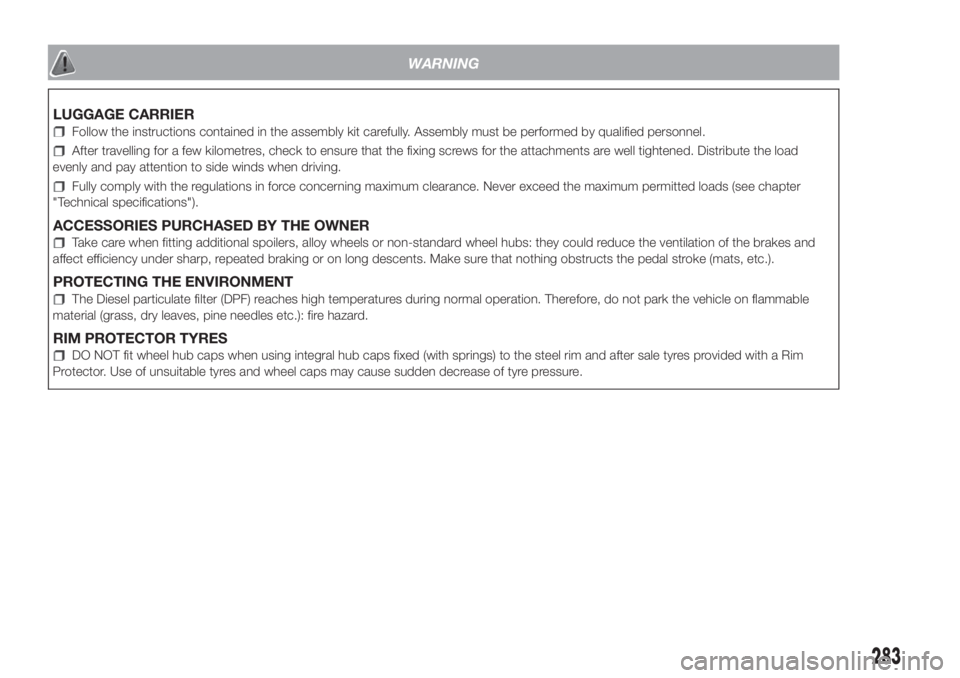
WARNING
LUGGAGE CARRIER
Follow the instructions contained in the assembly kit carefully. Assembly must be performed by qualified personnel.
After travelling for a few kilometres, check to ensure that the fixing screws for the attachments are well tightened. Distribute the load
evenly and pay attention to side winds when driving.
Fully comply with the regulations in force concerning maximum clearance. Never exceed the maximum permitted loads (see chapter
"Technical specifications").
ACCESSORIES PURCHASED BY THE OWNER
Take care when fitting additional spoilers, alloy wheels or non-standard wheel hubs: they could reduce the ventilation of the brakes and
affect efficiency under sharp, repeated braking or on long descents. Make sure that nothing obstructs the pedal stroke (mats, etc.).
PROTECTING THE ENVIRONMENT
The Diesel particulate filter (DPF) reaches high temperatures during normal operation. Therefore, do not park the vehicle on flammable
material (grass, dry leaves, pine needles etc.): fire hazard.
RIM PROTECTOR TYRES
DO NOT fit wheel hub caps when using integral hub caps fixed (with springs) to the steel rim and after sale tyres provided with a Rim
Protector. Use of unsuitable tyres and wheel caps may cause sudden decrease of tyre pressure.
283